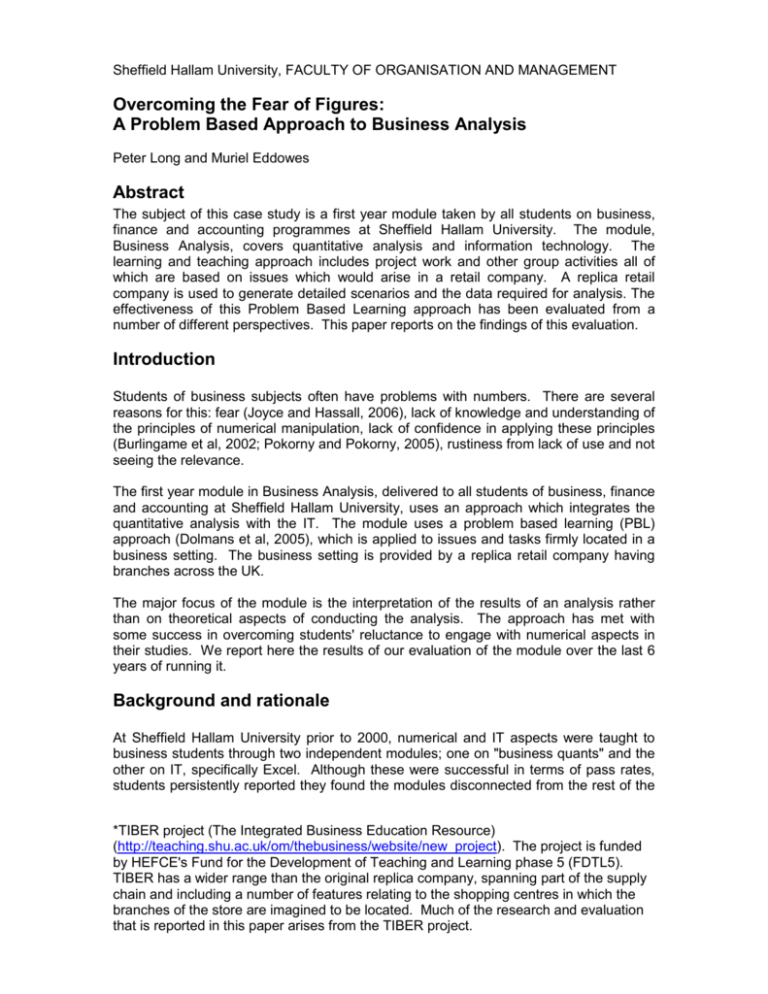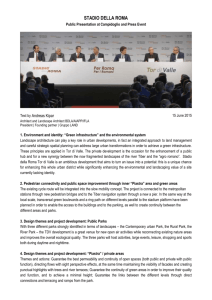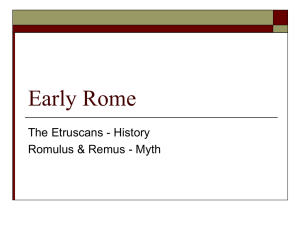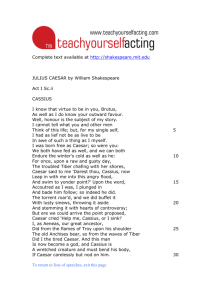here - the Sheffield Hallam University homepage
advertisement

Sheffield Hallam University, FACULTY OF ORGANISATION AND MANAGEMENT Overcoming the Fear of Figures: A Problem Based Approach to Business Analysis Peter Long and Muriel Eddowes Abstract The subject of this case study is a first year module taken by all students on business, finance and accounting programmes at Sheffield Hallam University. The module, Business Analysis, covers quantitative analysis and information technology. The learning and teaching approach includes project work and other group activities all of which are based on issues which would arise in a retail company. A replica retail company is used to generate detailed scenarios and the data required for analysis. The effectiveness of this Problem Based Learning approach has been evaluated from a number of different perspectives. This paper reports on the findings of this evaluation. Introduction Students of business subjects often have problems with numbers. There are several reasons for this: fear (Joyce and Hassall, 2006), lack of knowledge and understanding of the principles of numerical manipulation, lack of confidence in applying these principles (Burlingame et al, 2002; Pokorny and Pokorny, 2005), rustiness from lack of use and not seeing the relevance. The first year module in Business Analysis, delivered to all students of business, finance and accounting at Sheffield Hallam University, uses an approach which integrates the quantitative analysis with the IT. The module uses a problem based learning (PBL) approach (Dolmans et al, 2005), which is applied to issues and tasks firmly located in a business setting. The business setting is provided by a replica retail company having branches across the UK. The major focus of the module is the interpretation of the results of an analysis rather than on theoretical aspects of conducting the analysis. The approach has met with some success in overcoming students' reluctance to engage with numerical aspects in their studies. We report here the results of our evaluation of the module over the last 6 years of running it. Background and rationale At Sheffield Hallam University prior to 2000, numerical and IT aspects were taught to business students through two independent modules; one on "business quants" and the other on IT, specifically Excel. Although these were successful in terms of pass rates, students persistently reported they found the modules disconnected from the rest of the *TIBER project (The Integrated Business Education Resource) (http://teaching.shu.ac.uk/om/thebusiness/website/new_project). The project is funded by HEFCE's Fund for the Development of Teaching and Learning phase 5 (FDTL5). TIBER has a wider range than the original replica company, spanning part of the supply chain and including a number of features relating to the shopping centres in which the branches of the store are imagined to be located. Much of the research and evaluation that is reported in this paper arises from the TIBER project. curriculum and irrelevant to their course and future careers. Studying these topics was seen as a necessary evil rather than adding value to the rest of their studies. Many students became disengaged at an early stage and the resistance extended to subsequent modules in which numerical and analytical methods were used. Of the students who failed the module, a large number took several attempts before they either passed or withdrew from the course having failed these core modules. In 2000, when the business programme was being redesigned as part of the regular updating cycle, we took the opportunity of creating a new module called Business Analysis, which combined the quantitative analysis and the IT. This was a radical redesign that addressed a number of the shortcomings of its predecessors. It aimed to: (1) make the relevance of the quantitative analysis in business more explicit, (2) start simple and develop confidence, (3) provide help and encouragement to overcome fear and resistance, and (4) locate the subject more centrally within the curriculum. The perceived success of this module resulted, via subsequent updates of the Faculty's programmes, in all first year students who are studying courses in business, finance and accounting taking this 20 credit module in Business Analysis. In total a number of about 800 students take the module each year. These students have a wide variety of prior experiences in IT and Maths and many choose their degree subject in the belief that they will do very little, if any, numerical work. In 2004 a proposal was submitted for the further development of the replica retail company, which is central to the Business Analysis module, into a resource that could be used across other areas of the business curriculum. This proposal was accepted and work has been going on for the last three years on the TIBER project (The Integrated Business Education Resource).* The approach /methodology and method The initial challenge was to make the quantitative analysis and IT more exciting and relevant to the students. In the previous scheme where the quants and IT were taught separately from one another, the pass rate was acceptable but the general student feedback was that the subjects were not interesting and their relevance to the rest of the curriculum was not clear. Additionally, tutors reported that while on work placement, students could not successfully undertake analysis at the levels required of them. The objectives of the approach for a new Business Analysis module included the following: to integrate the quantitative analysis and IT so that calculations were done by the computer; to reduce the "mathematical" content i.e. simplify the theoretical aspects and remove the use of mathematical formulae; to adopt a project based learning approach, where activities are led by the needs of a business; *TIBER project (The Integrated Business Education Resource) (http://teaching.shu.ac.uk/om/thebusiness/website/new_project). The project is funded by HEFCE's Fund for the Development of Teaching and Learning phase 5 (FDTL5). TIBER has a wider range than the original replica company, spanning part of the supply chain and including a number of features relating to the shopping centres in which the branches of the store are imagined to be located. Much of the research and evaluation that is reported in this paper arises from the TIBER project. to set the whole module within the context of a realistic company. We explored various options for the realistic company that would form the backbone of the module. The nature of the analysis that was to be undertaken required access to detailed transactional data and it became clear that a commercial company would not allow such access to a group of around 800 people per year. We explored the idea of using a real business from within the University, the union shop for example, and even the idea of setting up a student run business for the purpose of generating the type of information and scenarios that would be analysed in the module. In the end we opted to build our own replica company and develop realistic (but not real) data and information. We chose a department store operating branches in a number of towns and cities in England. The company was loosely based on real retailing companies including John Lewis and Fenwicks Ltd. We chose a retail company because of the students' familiarity with this sector (as shoppers or as part time employees) which would enable a speedy orientation with the issues and data. Initially the tangible evidence of the replica company (which we called "the business") was a company website and a series of data files uploaded to the VLE site for the Business Analysis module. Subsequently, with the benefit of external funding which has supported the TIBER project, we have refined the website and added a company intranet website which holds the "commercially sensitive" detailed data and company information. Additionally we have extended the resource to include a logistics company and explicit links to shopping centres. These widen the scope of the resource in line with a wider remit to integrate the first year business curriculum. These websites are now freestanding so that they can be accessed from the VLEs of a number of different modules on the business programme. For the Business Analysis module the resource (TIBER) supplies issues, problems and data on which to base the practice and assessment of the quantitative analysis and IT tools and methods. The pedagogic model on which the module is based is shown below: *TIBER project (The Integrated Business Education Resource) (http://teaching.shu.ac.uk/om/thebusiness/website/new_project). The project is funded by HEFCE's Fund for the Development of Teaching and Learning phase 5 (FDTL5). TIBER has a wider range than the original replica company, spanning part of the supply chain and including a number of features relating to the shopping centres in which the branches of the store are imagined to be located. Much of the research and evaluation that is reported in this paper arises from the TIBER project. Figure 1: Pedagogic model for the Business Analysis module The module is divided into 8 study blocks of two weeks each. The remainder of the teaching year is devoted to directed study and student project work. There are two major assessed projects, one in each semester, which provide a basis for the work that the students undertake in the study blocks. The first project, covering topics from the first four study blocks, involves a team of 3 or 4 students presenting a report on the performance of their department in one of the branches of "the business". The report is via a poster and is a graphical representation of data and information, on both internal company performance and external market and competitor information. Students are allowed a five minute oral presentation to support their poster and have to answer questions on their findings. The second project relates to a proposed business development within the company and requires students (working in pairs) to apply a range of analytical methods to both historic company data and future estimates of market and competitor interest. The focus is on financial modelling and introduces notions of sensitivity analysis. This project requires students to write a management report which also develops their report writing skills. *TIBER project (The Integrated Business Education Resource) (http://teaching.shu.ac.uk/om/thebusiness/website/new_project). The project is funded by HEFCE's Fund for the Development of Teaching and Learning phase 5 (FDTL5). TIBER has a wider range than the original replica company, spanning part of the supply chain and including a number of features relating to the shopping centres in which the branches of the store are imagined to be located. Much of the research and evaluation that is reported in this paper arises from the TIBER project. Students work on these projects over the whole semester. They learn the methods and undertake practice exercises during the associated study blocks. They also build up their project work incrementally and receive formative feedback on progress by undertaking a number of small assessment tasks. Additionally, each study block has an associated on-line self assessment test so students can monitor their own development. The topic of each study block is introduced through a lecture and is supported by written learning materials (bound together in the module handbook). The IT skills required for the study block are developed through a 90 minute computer laboratory session comprising directed practice exercises. Students are required to prepare the results of their computer laboratory work for the following week's seminar session. The seminar sessions provide the opportunity to discuss and explore the interpretation of the work students bring to the class. Assessment The module centres on its assessment. The in-module assessment (2 projects, small assessed tasks, on-line self assessment tests) is intended to keep up the students' momentum and engagement throughout the year. There is also an end of module exam which assesses a general understanding of principles and the ability to apply them. During the 7 years of running the module, various changes have been made: the organisation of support materials has been rationalised; drop-in surgeries have been introduced; the number and frequency of assessed tasks have been changed. Many of these changes have been in response to student feedback on the module and what they like most and least about it. Evaluation The module has been evaluated in several ways: 1. Analysis of the student performance (through marks); We have tracked the students' performance in the Business Analysis module (and its predecessor modules) over the last 9 years. The series starts in 1999/2000 with the predecessor scheme. In this series we have considered only the quantitative analysis module of the predecessor scheme as it was this that was causing the greater concern. Figure 2 shows the average marks over the 9 year period. *TIBER project (The Integrated Business Education Resource) (http://teaching.shu.ac.uk/om/thebusiness/website/new_project). The project is funded by HEFCE's Fund for the Development of Teaching and Learning phase 5 (FDTL5). TIBER has a wider range than the original replica company, spanning part of the supply chain and including a number of features relating to the shopping centres in which the branches of the store are imagined to be located. Much of the research and evaluation that is reported in this paper arises from the TIBER project. 80 350 75 300 250 65 200 60 old scheme 150 55 no on module percent 70 average marks 100 50 50 45 Mean coursework mark Mean exam mark 40 0 1999/2000 2000/01 2001/02 2002/03 2003/04 2004/05 2005/06 2006/07 2007/08 Mean overall mark No. on the module year Figure 2: Average marks and numbers of students taking the module The introduction of the new scheme in 2001/02 produced a dramatic increase in the mean overall mark for the module (red line). The mean exam mark (green line) shows a similar pattern, although the mean coursework mark (blue line) shows an immediate decline but with an increase in the following year. As with any new module, there were refinements in the nature and balance of the assessment and these undoubtedly had an effect on average marks. However, there is a dramatic fall in all three mean marks in 2003/04. These have stabilised since and have now reached levels exceeding those of the old scheme. The dramatic falls in mean exam marks (in 2003/04 and 2006/07) coincide with reductions in numbers of students taking the module as shown by the purple line in the figure. The dips in these years indicate lower than usual recruitment levels, which may indicate a lower than usual standard of student entrant. Figure 3 shows, for the same time period, the pass rates for students completing the module *TIBER project (The Integrated Business Education Resource) (http://teaching.shu.ac.uk/om/thebusiness/website/new_project). The project is funded by HEFCE's Fund for the Development of Teaching and Learning phase 5 (FDTL5). TIBER has a wider range than the original replica company, spanning part of the supply chain and including a number of features relating to the shopping centres in which the branches of the store are imagined to be located. Much of the research and evaluation that is reported in this paper arises from the TIBER project. 100 pass rates 90 80 70 percent 60 old scheme 50 % pass 1st time 40 30 % with mark above 60% Cwk 20 10 % with mark above 60% Ex 0 1999/2000 2000/01 2001/02 2002/03 2003/04 2004/05 2005/06 2006/07 2007/08 year Figure 3: Pass rates and rates of good performance on the Business Analysis module In comparing the percentage of first time passes over this period, it is necessary to take account of a change in assessment regulations which were introduced in 2005/06. This change removed internal compensation between coursework and exam marks, making it necessary to separately pass both the coursework and exam components at 40%. To make a comparison meaningful we have standardised the pass rates on the basis of the previous set of assessment regulations (with internal compensation). The overall first time pass rate increases dramatically with the introduction of the new scheme and recovers from the dip in 2003/04 (where the numbers on the module fall) to a level above that before the new scheme was introduced. The two other series shows how the proportion of good performers (obtaining more than a 60% mark in coursework and exam respectively) has changed. Coursework performance took a hit with the new scheme but has recovered; exam performance showed an immediate improvement and has slowly recovered from the dip in 2003/04. 2. As part of regular questionnaires) module review (through end of module As part of regular module evaluation, questions relating to the resource have been included in the module evaluation questionnaire in each of the last two years. The statements relate to the replica company. The findings are shown below. *TIBER project (The Integrated Business Education Resource) (http://teaching.shu.ac.uk/om/thebusiness/website/new_project). The project is funded by HEFCE's Fund for the Development of Teaching and Learning phase 5 (FDTL5). TIBER has a wider range than the original replica company, spanning part of the supply chain and including a number of features relating to the shopping centres in which the branches of the store are imagined to be located. Much of the research and evaluation that is reported in this paper arises from the TIBER project. The number who see the replica company enhancing the relevance of the module to a business career has grown to a convincing majority. This shows how the resource has brought relevance to this part of the curriculum Figure 4: The use of the replica company helped me to understand the relevance of the module to a business career. The number who agree that the replica company helps to see connections between the different business subjects has grown over the last two years to a substantial majority. This supports the role of the resource in curriculum integration. Figure 5: The use of the replica company helped me to see connections between the different subjects I have studied this year. It seems that the replica company is seen as less realistic in 2007-08 than in the year before. This result could have been influenced by the introduction in 2007-08 of a critical appraisal of the company's web site undertaken as an exercise in the Financial and Information Management module. This exercise might have drawn attention to weaker aspects of the resource. Figure 6: The replica company, the business, was convincingly realistic. *TIBER project (The Integrated Business Education Resource) (http://teaching.shu.ac.uk/om/thebusiness/website/new_project). The project is funded by HEFCE's Fund for the Development of Teaching and Learning phase 5 (FDTL5). TIBER has a wider range than the original replica company, spanning part of the supply chain and including a number of features relating to the shopping centres in which the branches of the store are imagined to be located. Much of the research and evaluation that is reported in this paper arises from the TIBER project. The percentage of students claiming to find the website difficult to navigate has increased in 2007-08 than in the year before. This may due to the exercise mentioned in the previous question. Figure 7: The replica company's web sites were easy to navigate 3. As part of the funded TIBER project As part of the evaluation of the TIBER project, a series of on-line questionnaire surveys has been undertaken. The design of the survey was informed by student focus group meetings and a series of interviews with staff within the Faculty. The findings reported below derive from the analysis of the on-line surveys. Students study 6 modules in their first year. Five are mandatory. As the subject of one of the five mandatory modules was changed in 2007-08, only the four remaining modules have been included in this comparison. If each module was equally disliked among the students, then we would expect 17% of the students to claim each module as their least liked. Figure 8 below shows over 40% of students like Business Analysis the least in the cohort 2005-06. By 2007-08, this has reduced to just over 30%, which is a still a long way from being a reasonable expected value, but is a significant improvement since the start of the project. *TIBER project (The Integrated Business Education Resource) (http://teaching.shu.ac.uk/om/thebusiness/website/new_project). The project is funded by HEFCE's Fund for the Development of Teaching and Learning phase 5 (FDTL5). TIBER has a wider range than the original replica company, spanning part of the supply chain and including a number of features relating to the shopping centres in which the branches of the store are imagined to be located. Much of the research and evaluation that is reported in this paper arises from the TIBER project. Figure 8: Which module do you like the least? Figure 9 below shows the breakdown of the most liked modules over these three years. Figure 9: which module do you like the most? Again a proportion of about 17% would be expected for each module if each was equally liked. The chart below shows that only 4% of students claimed Business Analysis as their favourite. By 2007-08, this proportion had risen to over 15%, a level much more in line with expectations. *TIBER project (The Integrated Business Education Resource) (http://teaching.shu.ac.uk/om/thebusiness/website/new_project). The project is funded by HEFCE's Fund for the Development of Teaching and Learning phase 5 (FDTL5). TIBER has a wider range than the original replica company, spanning part of the supply chain and including a number of features relating to the shopping centres in which the branches of the store are imagined to be located. Much of the research and evaluation that is reported in this paper arises from the TIBER project. These results indicate that Business Analysis has become much more liked among the mandatory first year modules. Of course it could be that other modules have become less liked which is elevating the relative popularity of Business Analysis. The last year (2007-08) of this series of surveys also asked questions about the resource and the way it was used across the first year curriculum. This aspect was included as focus groups had emphasised the importance of real companies. This comes across clearly in this breakdown. Figure 10: realism is important to me A direct question on interest was asked and it is encouraging to see that a third of students agree that the use of the resource has increased their interest in the subject. Figure 11: use of resource increased my interest A much more encouraging result here, where nearly half of the students agree that the use of the resource has convinced them of the importance of the skills they are learning. *TIBER project (The Integrated Business Education Resource) (http://teaching.shu.ac.uk/om/thebusiness/website/new_project). The project is funded by HEFCE's Fund for the Development of Teaching and Learning phase 5 (FDTL5). TIBER has a wider range than the original replica company, spanning part of the supply chain and including a number of features relating to the shopping centres in which the branches of the store are imagined to be located. Much of the research and evaluation that is reported in this paper arises from the TIBER project. Figure 12: Using the resource convinced me skills are important These results show in general terms that the resource is well received by students and found to be useful in developing their skills. It is important to note that although a significant proportion agrees with these statements, a significant proportion are either neutral or disagree. This underlines the importance of recognising the differences in perception of such resources and the way they are received. What does this have to do with learner autonomy? The experience that we have described started out as a means to an end. We had a situation where disengaged students could not see the relevance of what they were studying and were being challenged to do things they were intellectually uncomfortable with. Learner autonomy was not such a key agenda item when our journey started as it is now. However, it became clear to us that what we were doing was strongly connected to the notion of developing learner autonomy in our students (Benson, P. & Voller, P., 1997). Since those taking the module are first year students, they suffer from all of the problems of adjusting to university study: encountering a change in the approach to teaching and learning, having to manage their own time (spent both on study and on other activities). For many, the subject is familiar to them (although it may have been treated in a different way previously), but for others the subject matter will be new and unfamiliar. Previously many will have had a poor experience with numbers and may have chosen to study business because of this poor prior experiences with the "harder" maths based subjects. Nearly all of these students are embarking on a journey which starts with a period of transition from the familiar to the unfamiliar. This journey also involves the path to becoming an autonomous learner. The pedagogic model underpinning this module includes notions of problem based learning (PBL) and assessment. As a pedagogic approach, PBL develops confidence and competence in facing a problem (a project) and achieving the required outcomes. The model relies on TIBER, a resource that presents information in a realistic and logically structured way. Appropriate use of the resource will encourage students to learn by discovery (action/activity based learning) within a semi-closed landscape. The module's main aim is to facilitate students developing their information skills. The transfer of the responsibility for researching and processing the information to the student is phased through graded exercises. Navigation through the information landscape can start with highly "way-marked" exercises. In the first Business Analysis project, for example, students are given precise instructions as to what they should do and how to find the information they need to do it. The next stage in the transfer might be categorised as "map reading". So, for example, in the second Business Analysis project, students are given precise instructions on what analysis to do, but little guidance on how to find the information they need to do it. The full evaluation requires them to go *TIBER project (The Integrated Business Education Resource) (http://teaching.shu.ac.uk/om/thebusiness/website/new_project). The project is funded by HEFCE's Fund for the Development of Teaching and Learning phase 5 (FDTL5). TIBER has a wider range than the original replica company, spanning part of the supply chain and including a number of features relating to the shopping centres in which the branches of the store are imagined to be located. Much of the research and evaluation that is reported in this paper arises from the TIBER project. outside of the replica environment and investigate real companies. The possibilities are then for "compass-bearing" activities in later stages of the programme. For example in the second year, students will encounter much less well structured exercises in the follow on module to Business Analysis. Further development There are two areas in which the module could be developed further. Firstly, an expansion and refinement of the structure and content of the resource (the replica company) upon which the module relies as its underpinning context to the application of the Problem Based Learning approach. Even though the externally funded project (TIBER) which supported the development of the resource has finished, data and information relating to the replica company continues to be updated on a regular basis. There is however potential for expanding the resource to incorporate relationships with companies supplying the retail company as well as improving the way in which the relationship between the company and the shopping centres is represented. Secondly, here are opportunities for improving the realism of the projects which students undertake as part of their problem based learning in order to move up the spectrum of autonomy described above. In the students’ second year follow on module, there is a development into “compass bearing” activities but, this could be improved. There are also areas for further evaluation of the module and the approach. An evaluation at a later stage in the programme, for example in the placement year, would produce useful information on the longer term effect of the approach on the students’ appreciation of business analysis methods and their confidence in applying them. The Integrated Business Education Resource (TIBER) had a wider objective of integrating the first year business curriculum by providing a resource that can be used across the curriculum. So far the use of the resource in other modules has been limited. A further development would be the redesign of all modules in the first year to make greater use of the resource’s potential through a PBL approach. The division of the curriculum into subject based modules provides a challenge to curriculum integration. A more ambitious development would be the design and development of modules which cut across subject areas and provided students with problem based learning opportunities that develop their appreciation of business as a holistic enterprise. References Benson P and Voller P (1997), “Autonomy and Independence in Language Learning”. London: Longman *TIBER project (The Integrated Business Education Resource) (http://teaching.shu.ac.uk/om/thebusiness/website/new_project). The project is funded by HEFCE's Fund for the Development of Teaching and Learning phase 5 (FDTL5). TIBER has a wider range than the original replica company, spanning part of the supply chain and including a number of features relating to the shopping centres in which the branches of the store are imagined to be located. Much of the research and evaluation that is reported in this paper arises from the TIBER project. Burlingame SM, Lebsack SA, Luthans KW, Palmer DK (2002), " Dazed and Confused: Business Students and Quantitative Analysis", 45th Meeting of the Midwest Academy of Management, April, 2002 Dolmans DHJM, De Grave W, Wolfhagen IHAP & van der Vleuten CPM (2005), “Problem-based learning: future challenges for educational practice and research”, Medical Education, 39, 7, pp 732-741 Joyce J and Hassall T (2006), "Communication apprehension and maths anxiety as barriers to communication and numeracy skills development in accounting and business education", Education and Training, 48, 6, pp. 454-464 Pokorny M and Pokorny H (2005), "Widening participation in higher education: student quantitative skills and independent learning as impediments to progression", International Journal of Mathematical Education in Science and Technology, 36, 5, pp 445–467 *TIBER project (The Integrated Business Education Resource) (http://teaching.shu.ac.uk/om/thebusiness/website/new_project). The project is funded by HEFCE's Fund for the Development of Teaching and Learning phase 5 (FDTL5). TIBER has a wider range than the original replica company, spanning part of the supply chain and including a number of features relating to the shopping centres in which the branches of the store are imagined to be located. Much of the research and evaluation that is reported in this paper arises from the TIBER project.








